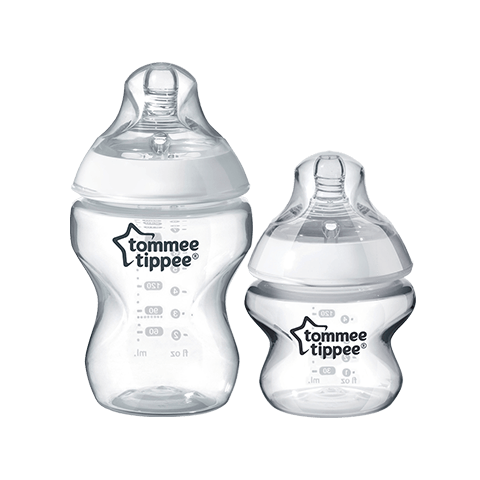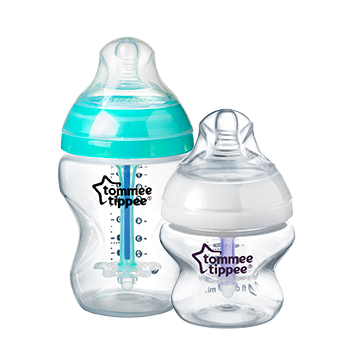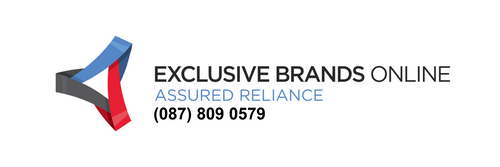Closer To Nature Bottles:

Closer to Nature Bottle
Getting Started
Great to see that you’ve purchased our Closer to Nature bottles. To help you get started and to keep your product working effectively, we’ve added all the guidance you should need within this area, as well as some handy hints and tips and troubleshooting advice.
Parts Guide
A step by step guide to all the component parts and how they can be fitted together.



How to use Tommee Tippee Baby Bottles
*Inspect before each use and pull the feeding nipple in all directions
** For safety and hygiene reasons it’s recommended that the feeding nipple is replaced every 2-months or sooner if damage or weakness is noticed
Where should the valve be when I'm feeding my baby?
The valve will work wherever it’s positioned but the best place for the valve is at the top, near your baby's nose.
Can I use Advanced Anti-Colic nipples on Closer to Nature bottles?
The simple answer is no, due to the different valves. Most of our products have interchangeable parts to make life as simple as possible. But the Closer to Nature nipples have a built-in air valve, and don’t work properly on our Advanced Anti-Colic bottles.
How long do nipples last?
Teats take quite a lot of hammering from little gums and teeth, so they need to be changed regularly. We recommend replacing nipples every 2-months or at the first sign of any damage or weakness.
Can I buy bottles with faster flowing nipples?
Most of our bottles currently come with slow flow nipples as standard, as they’re best for newborns and most parents generally stock up on bottles before baby arrives.
As your baby grows and can feed more quickly, you can buy faster flowing replacement nipples.
We have medium flow nipples, which most babies are ready for at around 3 months, and a fast flow nipple which is best from around 6 months. The ages are only guides though - you know your baby better than anyone and will be able to tell when they’re ready for a faster flow.

I've heard bad things about BPA - Is it in your bottles? (& What is it anyway?)
All Tommee Tippee bottles are BPA-free. They’re made of a plastic called polypropylene that’s lightweight, easy to clean, and completely safe. BPA - that’s (CH₃)₂C(C₆H₄OH)₂ for you science geeks - is a chemical that’s been used in some plastics since the 1960s and it’s believed to mess around with your hormones. It’s generally not good, so we don’t use it.
Can I store breast milk in bottles?
Yes, our bottles love to look after your breast milk. We even have special lids that you can pop on to store your milk in the fridge or freezer. If you’re pumping and storing breast milk, our Pump and Go™ range may be handy too - it features a clever pouch that you use to pump, store, warm and feed (it’s our all in one show). This means there’s no need to transfer milk at any stage, so you’ll never lose a precious drop.
Can I recycle my bottles when I'm done?
Yes. Our Closer to Nature and Advanced Anti-Colic bottles are made from polypropylene (PP) that can happily be recycled.
Cleaning & Maintenance
- Before first use, disassemble all parts and place in boiling water for 5 minutes, this is to ensure good hygiene
- Clean before first and each use
- Always wash the product immediately after each use
- Clean in warm soapy water or in dishwasher (top shelf only)
- For cleaning, use a TT bottle and nipple brush
- Sterilize all parts of the bottles after cleaning and before use (all bottle parts are suitable for sterilization by steam (electric or microwave), boiling or cold-water tablet/liquid solution.
- Inspect before each use and pull the feeding nipple in all directions
- Throw away at first sign of damage or weakness
- For safety and hygiene reasons it’s recommended that the feeding nipple is replaced every 2-months
DON'TS
- Do not clean or allow to come into contact with harsh chemicals
- Do not allow product to come into contact with oil-based foods e.g. tomato based sauces or carrots
- Do not turn the nipple inside out for cleaning as damage could result
- Store or leave in direct sunlight or near a source of heat, or leave in disinfectant (“sterilizing solution”) for longer than recommended as this may weaken the nipple
- Not suitable for use in a conventional oven or a combination microwave with the grill feature switched on
- Do not heat in a microwave with the bottle sealed. Remove the nipple, screw ring and bottle hand first

WARNINGS
FOR YOUR CHILDS SAFETY & HEALTH WARNING!
- ALWAYS use this product with adult supervision. Accidents have occured when babies have been left alone with drinking equipment due to the baby falling or if the product has been dissassembled
- Always check food temperatures before feeding. Heating in a microwave oven may produce localized high temperatures. Take extra care when microwave heating
- Always stir heated food to ensure even heat distribution and test the temperature before serving
- When making up a feed, follow the formula milk manafacturer's instructions and allow the freshly boiled water to cool before pouring it into the bottle
- NEVER use feeding nipples as a pacifier
- Prolonged sucking of fluids will cause tooth decay. Tooth decay in young children can occur even when non-sweetened fluids are used. This can occur if the baby is allowed to use the bottle for long periods through the day and particularly through the night, when saliva flow is reduced or if it is used a pacifier

Is it ok to put bottles in the dishwasher?
Of course! Pop them on the top shelf though. As with all white and clear plastic things they can get a bit stained and yucky-looking in the dishwasher (blame that Bolognese sauce or carrot soup you had last night). If they do get discolored there’s nothing to worry about - they’re perfectly safe, they just don’t look as nice.
Can I recycle my bottles when I'm done?
Yes. Our Closer to Nature and Advanced Anti-Colic bottles are made from polypropylene (PP) that can happily be recycled.
Troubleshooting
Why is my bottle misshapen?
Our bottles have a unique ‘waisted’ design that makes them cute and easy to hold. If your bottle has lost its shape, it could be that the water which was poured in was still too hot. Doing this can cause a vacuum effect, where the bottle sucks inwards, making it a very odd shape indeed. The best bet (as endorsed by WHO - World Health Organisation) is to let freshly boiled water cool for around 30 minutes before making up a feed. This will make sure your Tommee Tippee bottle keeps its cute waisted shape.
My teats don't seem to last very long?
Teats take quite a lot of hammering from little gums and teeth, so they need to be changed regularly. We recommend replacing teats every 2-months or at the first sign of any damage or weakness.
Why has the decoration/ measurements rubbed off?
First of all – whilst we appreciate that this will be frustrating, please be assured that the ink used on our bottles is food grade certified, so it poses no harm to your little one if it ends up in their mouth, on their fingers or anywhere else.
We test all of our bottles and do our best to stop this from happening.
Here are a few things to think about, based on feedback from parents and real-world experience:
- How long have you been using your bottle(s)?
We’d love our bottles to last a lifetime, but general wear and tear can occur after months of use, especially if you’re using, washing and sterilizing the same bottle each and every day.
- How are you washing your bottle(s)?
Hand washing in warm soapy water or placing into the dishwasher on the top shelf is ideal. Scrubbing or placing into the bottom of a dishwasher could damage the decoration/ measurements causing the ink to come away.
- How are you sterilizing your bottle(s)?
All methods of sterilization are perfectly fine, although strong cold-water sterilization, or keeping them in the solution for longer than needed could affect the decoration/ measurements and generally make your bottles and teats look a little cloudy.

Advanced Anti-Colic Bottles
Getting Started
Great to see that you’ve purchased our Advanced Anti-Colic bottles. To help you get started and to keep your product working effectively, we’ve added all the guidance you should need within this area, as well as some handy hints and tips and troubleshooting advice.
The unique anti-colic venting system draws air through the vents in the venting wheel, down the venting tube and out of the star valve into the air space at the base of the bottle bypassing the milk, reducing the air taken in during feeds.
Parts Guide
Here’s a handy step by step guide to all the component parts and how they can be fitted together.

Quick Start
Before you use your bottles for the first time, please:
- Disassemble all parts and remove the star valve and venting wheel from the venting tube. Place all parts in boiling water for 5 minutes. This is to ensure good hygiene and to encourage the star valve to open. You may still need to gently pinch the star valve to open it.
- Then follow the special cleaning instructions for Advanced Anti-Colic bottles.
- Check that the slit in the star valve is open by holding it up to the light. If it has sealed shut, pinch it gently between your fingers to re-open.
Special cleaning instructions for your Advanced Anti-Colic bottles
- Disassemble all parts and remove the star valve and venting wheel from the venting tube. If using for the first time, please separate all parts and place in boiling water for 5 minutes. This is to ensure good hygiene and to encourage the star valve to open. You may still need to gently pinch the star valve to open it.
- Wash all parts in warm soapy water or place in the top shelf of a dishwasher.
- DO NOT leave the star valve on the venting tube when cleaning. DO NOT use the venting tube cleaning brush to clean the star valve. These actions can damage the valve and cause your bottle to leak.
- Rinse all parts using clean water. Reassemble the star valve, venting tube and venting wheel and sterilize.
- Check that the slit in the star valve is open by holding it up to the light. If it has sealed shut, pinch it gently between your fingers to re-open.
- Allow the venting tube with heat sensing strip to return to room temperature before testing the temperature of a feed.
- After use, wash all parts in warm soapy water, following the special cleaning instructions, rinse in clean water, ready to sterilize once more.
Making up a bottle of formula for your baby using the Advanced Anti-Colic bottle
The Advanced Anti-Colic bottle is different from other bottles because of its unique anti-colic features. That means you have to make up a bottle in a slightly different way than you may be used to. Don't worry, it will soon become routine.
Using boiling water to prepare formula with Advanced Anti-Colic bottles
- Clean all parts of the bottle and anti-colic venting system thoroughly. Please follow the special cleaning instructions.
- Boil water in a kettle or pan and allow to cool for 30 minutes.
- Add the cooled, boiled water to the anti-colic bottle base and add the appropriate amount of formula.
- Avoid shaking the bottle to mix the formula, as this can add air into the milk which can increase colic symptoms. We suggest that you stir the formula gently with a spoon to mix the feed.
- We recommend reassembling the anti-colic venting system before sterilizing, so it should already be assembled. If not, please refer to the diagram to connect the star valve, venting tube and venting wheel together. Check that the slit in the star valve is open by holding it up to the light. If it has sealed shut, pinch it gently between your fingers to re-open.
- Make sure that the venting tube is at room temperature before testing the temperature of the feed. Dip the tube for 10 seconds. If the heat sensing strip shows solid pink, then the feed may be too hot. Allow the feed to cool further before feeding your baby.
- Once your feed is at the right temperature, finish assembling the bottle by putting the connected star valve, venting tube and venting wheel inside, then placing the hood on top of the anti-colic teat with screw ring and attaching to the bottle base. DO NOT shake the bottle.
Always check the temperature of the formula mix before feeding your baby.
Important note:
Only Advanced Anti-Colic nipples will work with Advanced Anti-Colic bottles. Check that your nipples says anti-colic on it.
DO NOT USE Closer to Nature nipples on Advanced Anti-Colic bottles.
Using the wrong nipple on your Advanced Anti-Colic bottle will reduce the effectiveness of the anti-colic system and may cause your bottles to leak.
*Inspect before each use and pull the feeding nipple in all directions
** For safety and hygiene reasons it’s recommended that the bottle nipple is replaced every 2-months or sooner if damage or weakness is noticed



What happens if I put the venting tube in straight after making a feed?
Placing the venting tube into boiling or hot liquid won’t damage it, but it may force liquid up the tube which can cause your bottle to leak when it’s assembled. The heat sensing strip on the side of the venting tube will naturally turn bright pink to warn that the liquid is too hot. We recommend following our ‘how to guide’ to make a feed.
What’s the best way to test the feed temperature when using the venting tube?
Make sure that the venting tube is at room temperature before testing the temperature of the feed. Dip the tube for 10 seconds. If the heat sensing strip shows solid pink, then the feed may be too hot. Allow the feed to cool further before feeding your baby.
There’s no need to put the venting tube all the way in – simply dip the tube into the feed and remove it to see the color of the heat sensing strip. About an inch into the feed should be all you need to test the temperature.
Always check the temperature of the feed before feeding your baby.
Closer to Nature nipples look the same, can I use them on Advanced Anti-Colic bottles?
No, you can’t use Closer to Nature nipples on Advanced Anti-Colic bottles. Closer to Nature nipples have a built-in air valve, and don’t work with our Advanced Anti Colic bottles. The valve in your Advanced Anti Colic bottles is situated inside the bottle, attached to the end of the venting tube and is shaped like a star. It’s important that you make sure you match the right nipple to the right bottle.
Can I store breast milk in bottles?
Yes, our bottles love to look after your breast milk. We even have special lids that you can pop on to store your milk in the fridge or freezer. If you’re pumping and storing breast milk, our Pump and Go™ range may be handy too - it features a clever pouch that you use to pump, store, warm and feed (it’s our all in one show). This means there’s no need to transfer milk at any stage, so you’ll never lose a precious drop.
How long do nipples last?
Teats take quite a lot of hammering from little gums and teeth, so they need to be changed regularly. We recommend replacing nipples every 2-months or at the first sign of any damage or weakness.
Can I buy bottles with faster flowing nipples?
All of our bottles currently come with slow flow nipples as standard, as they’re best for newborns and most parents generally stock up on bottles before baby arrives.
As your baby grows and can feed more quickly, you can buy faster flowing replacement nipples.
We have medium flow nipples, which most babies are ready for at around 3 months, and a fast flow nipple which is best from around 6 months. The ages are only guides though - you know your baby better than anyone and will be able to tell when they’re ready for a faster flow.

I've heard bad things about BPA - Is it in your bottles? (& What is it anyway?)
All Tommee Tippee bottles are BPA-free. They’re made of a plastic called polypropylene that’s lightweight, easy to clean, and completely safe. BPA - that’s (CH₃)₂C(C₆H₄OH)₂ for you science geeks - is a chemical that’s been used in some plastics since the 1960s and it’s believed to mess around with your hormones. It’s generally not good, so we don’t use it.
Can I recycle my bottles when I'm done?
Yes. Our Closer to Nature and Advanced Anti-Colic bottles are made from polypropylene (PP) that can happily be recycled.

